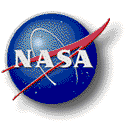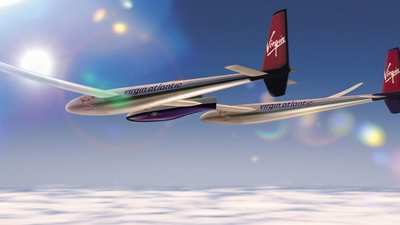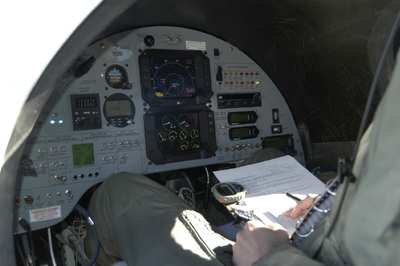Thu, Mar 03, 2005
Providing State-Of-The-Art Video Communications For Fossett's
Flight
 The Virgin Atlantic Global Flyer
project team has joined forces with National Aeronautics and Space
Administration (NASA) to test state-of-the-art live video
communications equipment during the Virgin Atlantic Global Flyer
record attempt. The equipment will enable pilot Steve Fossett to
communicate more easily and effectively with Mission Control by
providing clear live video images with audio from the aircraft back
in Mission Control.
The Virgin Atlantic Global Flyer
project team has joined forces with National Aeronautics and Space
Administration (NASA) to test state-of-the-art live video
communications equipment during the Virgin Atlantic Global Flyer
record attempt. The equipment will enable pilot Steve Fossett to
communicate more easily and effectively with Mission Control by
providing clear live video images with audio from the aircraft back
in Mission Control.
The equipment has been developed as part of NASA’s Space
Based Telemetry and Range Safety System (STARS) project to design
and develop communications equipment for reusable space craft (like
the Space Shuttle).
"STARS is a multi center NASA proof-of-concept project to
determine if operational costs can be reduced and operational
flexibility increased by using space-based communication systems to
relay tracking data and vehicle telemetry from reusable launch
vehicles to the ground, and to relay flight termination signals
from the ground to a vehicle," said Lisa Valencia, STARS Project
Manager at NASA. "This equipment has the potential of reducing the
cost and infrastructure of the current ground-based communication
systems composed of numerous radar, telemetry and command control
sites. For the Virgin Atlantic Global Flyer flight, the Space Based
Telemetry and Range Safety System (STARS) experiment was modified
to provide the capability of transmitting 113 kbps video data of
the pilot during the three day world flight."

STARS is made up of a Range Safety System and a Range User
System. The Range Safety System sends tracking data from the
vehicle to the ground via satellite and receives flight termination
commands from the ground via satellite. The Range User System sends
high data rate vehicle telemetry from the vehicle to the ground via
satellite.
"I am delighted to be able to test this equipment onboard my
round-the-world flight," Fossett said. "It is a fantastic
opportunity to help NASA with equipment testing which could help
technology for future space flights while also benefiting the
Virgin Atlantic Global Flyer record attempt. This equipment will
not only enhance communications between myself and Mission Control
during the attempt but will also provide all those following the
attempt through the website with up to the minute footage from the
plane."
To accomplish the task of transmitting 113 kbps video data of
the pilot during the three day round-the-world flight, a video
encoder and STARS hardware had to be combined into a consolidated
unit and interfaced to the flight antenna and cockpit camera system
on the aircraft. The KSC ground station required modifications to
decode the data stream (cockpit video signal) received from TDRS
into a standard video stream.

The KSC Telescience Lab supported the ground station
redistribution of the cockpit video signal back to the Mission
Control center in Kansas. They also provided streaming video with
encoded audio and still video captures, as well as the complete
archival of the footage from the flight.
More News
From 2014 (YouTube Version): Innovative Aerodynamic Technologies Produce Game-Changing Results At the NBAA 2013 convention, ANN CEO and Editor-In-Chief, Jim Campbell had a chance t>[...]
“This plan opens insurance options to a much wider variety of Canadian aviators across the country who have otherwise had more challenges with securing insurance coverage... >[...]
Taxi The movement of an airplane under its own power on the surface of an airport (14 CFR section 135.100 [Note]). Also, it describes the surface movement of helicopters equipped w>[...]
Aero Linx: The Vertical Flight Society (VFS) The Vertical Flight Society, formerly the American Helicopter Society, is the non-profit technical society for the advancement of verti>[...]
Also: Sustainable Aircraft Test Put Aside, More Falcon 9 Ops, Wyoming ANG Rescue, Oreo Cookie Into Orbit Joby Aviation has reason to celebrate, recently completing its first full t>[...]
 Classic Aero-TV: Active Winglets -- Tamarack Aerospace Partners with Cessna
Classic Aero-TV: Active Winglets -- Tamarack Aerospace Partners with Cessna Aero-News: Quote of the Day (05.03.25)
Aero-News: Quote of the Day (05.03.25) ANN's Daily Aero-Term (05.03.25): Taxi
ANN's Daily Aero-Term (05.03.25): Taxi ANN's Daily Aero-Linx (05.03.25)
ANN's Daily Aero-Linx (05.03.25) Airborne 05.02.25: Joby Crewed Milestone, Diamond Club, Canadian Pilot Insurance
Airborne 05.02.25: Joby Crewed Milestone, Diamond Club, Canadian Pilot Insurance





